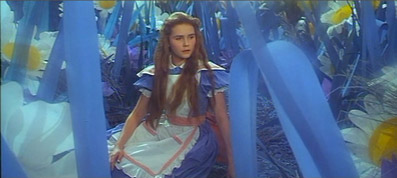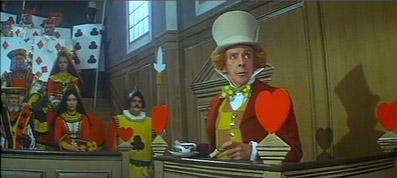| |
"'The trial cannot proceed,' said the King in a very grave voice, 'until all the jurymen are back in their proper places— all,' he repeated with great emphasis, looking hard at Alice as he said so." |
| |
From the last chapter of Alice's Adventures In Wonderland
by Lewis Carroll (aka the Reverend Charles Dodgson) |
Just in case we're in any doubt... this is not a review of the latest and record breaking 3D version of the oft-told tale. It's a 1972 production. For the review of Burton's version, click here. I can't think why this DVD is released at the same time as Burton's cinematic sweet shop. I mean, people might get confused and buy this thinking... (hey ho)...
Judging a version of the classic children's story produced in 1972 so soon after being pleasantly assaulted by Tim Burton's IMAX 3D, CG soaked interpretation is a tricky feat in and of itself. How does anyone banish Burton's brain bucket of phantasmagoria and embrace special effects and make up barely out of nappies in cinematic evolutionary terms? This version of the tale had one aspect going against it big time (for me, on a personal level) and several going for it. On the plus side, it seems as if every A and B list (at the time) British actor is in the cast. It's full to the brim with famous names and faces, some of whom are slightly and in some cases wholly obscured by make up. Secondly, it was shot by Geoffrey Unsworth OBE. There is neither time nor room here to celebrate this icon of British cinematography but please, IMDB the dear man (and there is a lot of proof out there that he was dear – no expense based pun intended – and hugely regarded for his craft and humanity). His is the name that sadly appears first as a dedication at the end of Richard Donner's Superman. So there would be no doubt to me that his contribution to Carroll's surreality would be worth pouring into my grateful eyes.

Still on the plus side, John Barry is no slouch as a composer (like Burton, Barry has his singular signature writ musically and there are echoes of his early Bond scores in this rather sugary main theme). But to my knowledge, he'd not scored an out and out musical. The lyricist Don Black (together with Barry) has given us some unforgettable classics (Goldfinger anyone?) Still, I remained wary about the musical aspect (my number one con to the above pros) and after the first number, 'Curiouser and Curiouser', my wariness had turned to quiet resignation. I was as unmoved by the song as I could have been. Very few movies work as musicals without the impression that you call a halt to a film so a song can be sung. Ridiculous. When the numbers grow organically from the piece and appear as if the film could not exist without them, then we're cooking. Just take a look at Singin' In The Rain – one of the most sublime examples of Hollywood at its finest, a musical good enough to eat. Alice's Adventures In Wonderland is a musical good enough to leave in the fridge and get someone else to identify it. But then again, interpretations of Alice have varied wildly and there is no reason a musical version couldn't work (aside from the fact that musicals these days are as fashionable as Abba – hmm, that's a point). Yes, film-makers try to recreate the same 'musical' vibe by being overtly theatrical but aside from Mamma Mia, we've not had a musical 'musical' for some time (I guess South Park Bigger Longer and Uncut was the last true musical I saw in the cinema). And that had the added bonus of being bloody funny. I have yet to see Rob Marshall's 9.
The only real energy inherent in 1972's Alice is provided by a couple of goons, a seriously badass ballet dancer and half a Pete 'n' Dud. Spike Milligan's younger physicality as the Gryphon is a joy. I can't watch Milligan in anything and be uninvolved. He's one of those magical performers who will forever transcend his context. Fellow goon, Peter Sellers, plays the March Hare with some gusto and next to him fighting sleep is the irrepressible Dudley Moore as the Dormouse. You have to understand that the make-up effects are less Planet Of The Apes and more Christmas Panto. Ex-Red Shoes alumni, Robert Helpmann (known to all of my generation as the Child Catcher from Chitty Chitty Bang Bang) has a good stab as the Mad Hatter (he actually resembles the character of the Tenniel illustrations) but all the actors are undone by a lacklustre production design and a significant flaw in the original, albeit classic, story.

I'm sorry, but I've never understood how this particular classic earned its status. At least Burton's remake attempts a few dramatic throughways. Left alone, the text is intriguing and wholly visual but curiously un-dramatic. Is that the curse of the 'we-know-it's-a-dream' story? There is nothing at stake. It's curious as Alice might say. Fiona Fullerton is a serviceable Alice (apologies if that sounds a little odd) but again, she's a bit old for the part. She was 16 but exuded a much more mature character. The original Alice was supposed to be 10. There is an enormous difference between 10 and 16 when it comes to little girls. The difference in maturity is almost impossible to gauge but Fullerton did serve as one of Roger Moore's Bond's many conquests and as a 16 year old she may have sort of looked like a child but she had reached the tipping point of maturity. OK, OK, sexual maturity. Happy now? That changes everything. Boys and girls may turn into men and women so suddenly you need a squeegee for your specs but there's no denying the charge of nascent sexuality in those who suddenly find themselves armed with power/weapons they neither asked for nor have a manual to read on how to use them. Ignorance of power has a lustre all of its own and for once, I'd like to see an Alice devoid of Freudian hypothesis – a 10 year-old, simple little girl. Is there such a thing?
Political correctness and draconian health and safety had not permeated into 70's culture and so we are treated to a real baby (presumably or one of the best animatronics I've ever seen) being terrorised by the Duchess and cook in a scene that's quite difficult to watch. One assumes the baby's parents were on hand but that newborn looks genuinely distressed (OK, it turns into a pig a little later but that's not the point). This scene, overplayed with relish by Patsy Rowlands and Peter Bull, reminded me how much freedom we used to have (not necessarily to terrorize babies) and how much control has been wrested from the artist and given carte blanche to the overseer. Director William Sterling, perhaps hampered by special effects constraints, has delivered a bland Wonderland and a whole host of thespianic turns designed to dazzle the audience into thinking there is more substance than there actually is but perhaps that accusation could be laid at Carroll's door. The best I can say about this curious production is that it's not often a film-maker assembles a stellar cast and then proceeds to cover everyone up in prosthetics, wigs and animal suits so their marquee value becomes negligible. Is that the best I can say? Uh... uh...
Presented, bizarrely and one assumes cheaply, in a letterboxed not anamorphic format, this edition gives the impression that it's only out there for no other reason than to ride the coat-tails of its latest more sophisticated incarnation. There has been very little care taken with what I imagine would be sumptuous photography (Geoffrey Unsworth doesn't have 'off' days). The colours are muted and the contrast very low. Of course, special effects were acheived optically in 1972 so there is some degradation of the image when the FX start piling up. That said, the shrinking and enlarging Alice (in camera FX one imagines) is done rather skilfully.

The mono sound is faithfully presented in Dolby Digital but it's certainly no restoration job. There are no subtitles or dubbing of any kind. This is the very definition of vanilla.
Nada... Zip. This sort of confirms why this was released – no great effort made except the very smallest.
A curio for Wonderland completists only, the disc is a lacklustre presentation of a movie that should at the very least be a colourful addition to the Carroll canon.
|